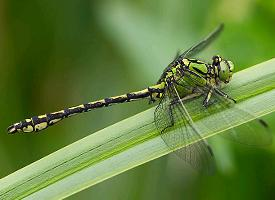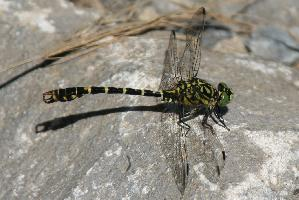
Váhy a míry
| Délka | od 55 do 60 m |
|---|---|
| Délka rozpětí křídel | od 65 do 75 mm |
Popis zvířete
The Green Snaketail, scientifically named Ophiogomphus cecilia, is a captivating species of dragonfly belonging to the Gomphidae family. This intriguing insect is primarily found across various regions of Europe, stretching from the Iberian Peninsula in the west to parts of Asia Minor in the east, and as far north as Scandinavia. Its presence is indicative of the health of freshwater ecosystems, as it prefers clean, flowing waters for its habitat.Adult Green Snaketails are visually striking, marked by their vibrant green thorax, which is where they get their common name from. Their bodies are elongated and slender, with a total length ranging from 45 to 50 millimeters, making them a medium-sized species within the dragonfly family. The abdomen, contrastingly colored in a darker hue, features yellow markings that add to their distinctive appearance. Their eyes are large and compound, providing them with an excellent field of vision to spot prey and evade predators.
One of the most fascinating aspects of the Green Snaketail's morphology is its wings. The wings are transparent, with a span that can reach up to 70 millimeters. They are held perpendicular to the body when at rest, a characteristic feature of the species. The wingtips are adorned with dark pterostigmas, which are thicker cells that help in stabilizing flight. This adaptation is crucial for their agile flying abilities, allowing them to dart and hover with precision as they hunt for insects over the water's surface.
The life cycle of the Green Snaketail is as intriguing as its appearance. Beginning life as an egg, it undergoes a remarkable transformation through its larval stage, which can last for several years. The larvae, known as nymphs, are aquatic predators, residing in the sediment of clean, well-oxygenated rivers and streams. They exhibit remarkable camouflage, blending seamlessly with their surroundings to ambush prey. As they mature, the nymphs undergo metamorphosis, emerging from the water as fully formed adults, ready to take to the skies.
Breeding season for the Green Snaketail brings about a spectacular display, as males fiercely defend their territories along the riverbanks, waiting for the opportunity to mate. The females lay their eggs by dipping their abdomen into the water while in flight, dispersing them among aquatic vegetation where they will hatch and begin the cycle anew.
Despite their beauty and ecological importance, the Green Snaketail faces threats from habitat destruction, pollution, and the alteration of waterways. Their reliance on clean, flowing waters makes them particularly vulnerable to changes in water quality and hydrology. Conservation efforts are crucial to ensure the survival of this species, highlighting the need to preserve natural river ecosystems not only for the Green Snaketail but for the myriad of other species that depend on these habitats.
In summary, the Green Snaketail is a remarkable dragonfly species, known for its striking green thorax, agile flight, and intricate life cycle. As an indicator of freshwater health, its presence underscores the importance of conserving natural water bodies. The Green Snaketail not only adds to the biodiversity of its habitat but also captivates those fortunate enough to observe it in the wild, serving as a reminder of nature's intricate beauty and the need to protect it.
Podobná zvířata
Nové fotografie zvířat
Top 10 zvířat
- Diana monkey (Cercopithecus diana)
- Dolphin gull (Leucophaeus scoresbii)
- Galápagos tortoise (Geochelone nigra complex)
- Moustached guenon (Cercopithecus cephus)
- Japanese spider crab (Macrocheira kaempferi)
- Stone loach (Barbatula barbatula)
- Colossal squid (Mesonychoteuthis hamiltoni)
- Common house mosquito (Culex pipiens)
- Common reed warbler (Acrocephalus scirpaceus)
- Sea urchins (Echinoidea)


